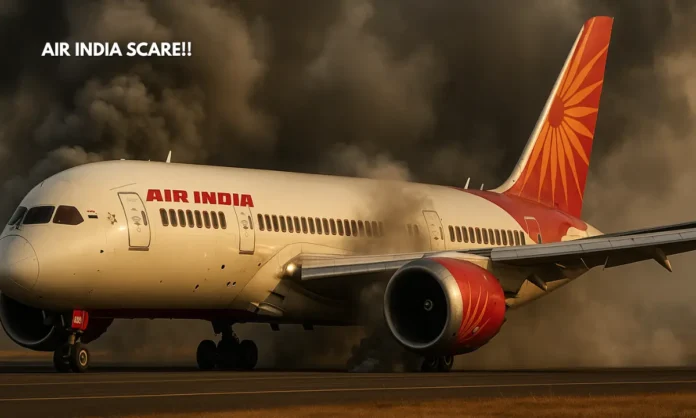SUMMARY
- Air India’s San Francisco–Mumbai flight AI180 was forced to delay departure from Kolkata due to a serious engine snag discovered after landing.
- Passengers were deplaned after a 4-hour wait as a precautionary measure, just five days after another Air India jet crashed fatally in Ahmedabad.
- The incident fuels rising questions about Air India’s fleet maintenance amid growing scrutiny from aviation authorities and international flyers.
A Second Shock Grounding in Less Than a Week
Barely five days after a tragic Air India Dreamliner crash in Ahmedabad killed over 240 people, the airline faced another serious safety scare—this time with Flight AI180 operating from San Francisco to Mumbai. While no one was harmed, the incident has reignited scrutiny around fleet maintenance, oversight, and operational transparency at India’s national carrier.
The AI180 Boeing jet, which had taken off as scheduled from San Francisco, landed at Kolkata’s Netaji Subhas Chandra Bose International Airport at 12:45 am on June 17 for a scheduled halt. It was during routine inspections post-landing that ground engineers discovered a technical snag in the aircraft’s left engine. As precautionary protocols kicked in, the departure was delayed significantly. By 5:20 am, after nearly five hours on the tarmac, passengers were asked to deplane.
This isn’t an isolated case—it’s the second major Air India incident in less than a week. The previous one, flight AI-171 from Ahmedabad to London, ended in a catastrophic crash, claiming the lives of almost everyone onboard except one British national. It marked the first fatal incident involving a Boeing 787-8 Dreamliner globally, prompting international concern.
Modi Govt has sold people's lives along with country's wealth
— Taj INDIA (@taj_india007) June 17, 2025
Air India flight AI180 from San Francisco to Mumbai developed a technical snag on Tuesday morning, passengers were deboarded at Kolkata airport!#modifailsbihar#TelAviv #IranIsraelConflict#SanatanDharma #ClothBank pic.twitter.com/QZL7tUAtA9
Engine Failure and Emergency Culture: What AI180 Reveals
- The engine snag was discovered post-landing, indicating a possible in-flight anomaly that was narrowly managed.
- Deplaning passengers only after four hours raises operational questions around decision-making timelines in technical emergencies.
- The incident occurred amidst heightened regulatory inspection post the Ahmedabad crash, placing additional pressure on airline protocol.
While Air India’s pilot on AI180 reportedly told passengers the delay and deplaning were done “in the interest of safety,” the broader narrative suggests something more troubling: the visible strain on the airline’s engineering and response systems. That the snag was not caught pre-flight in San Francisco points to potential inspection gaps in long-haul transcontinental aircraft checks.
Moreover, the nearly five-hour wait before evacuation raises the question—why wasn’t a swift deplaning order issued earlier, particularly when India’s aviation sector is reeling from one of its deadliest tragedies?
With the Directorate General of Civil Aviation (DGCA) already under pressure to inspect Air India’s entire Boeing fleet post-AI-171, this latest scare will likely accelerate a deeper audit of technical preparedness and the real-time decision-making culture within Air India’s operational command.
Safety, Silence, and Systemic Strain: A Dangerous Mix
- Air India has not issued a detailed statement or timeline breakdown for the AI180 incident.
- Boeing 787s, though modern, are increasingly becoming the focus of recent aviation troubles globally.
- Repeated incidents risk eroding international trust in Indian carriers amid global tourism recovery.
What’s missing from Air India and the DGCA in the aftermath of this event is transparency. No detailed technical statement has been made public yet, and updates on the exact nature of the engine defect remain ambiguous. In contrast, other global carriers release full post-incident logs within hours of similar technical halts.
The lack of public clarity feeds growing unease. Aviation experts have begun questioning if Air India’s transition under Tata Group ownership has done enough to retool internal accountability or merely preserved legacy inefficiencies. Moreover, Boeing’s 787 Dreamliners—though technologically advanced—are now under a shadow, as multiple recent incidents globally have involved variants of the aircraft.
If not handled with honesty and urgency, the AI180 event could further damage Air India’s international brand equity, particularly among foreign travellers and diaspora flyers who are already wary after the Ahmedabad crash.
Flight Risk: A National Carrier at Crossroads
The twin crises—AI171’s crash and AI180’s near-emergency—paint a disturbing picture of operational fragility at India’s flag carrier. With global eyes now firmly fixed on Air India’s safety record, its leadership must act decisively. Not just in fixing engines, but in rebuilding trust.
India’s aviation dreams hinge on robust safety, not blind expansion. If Air India is to remain credible in a post-pandemic, hyper-competitive sky, transparency, overhauls in fleet inspection standards, and proactive public communication are no longer optional—they are imperative.


